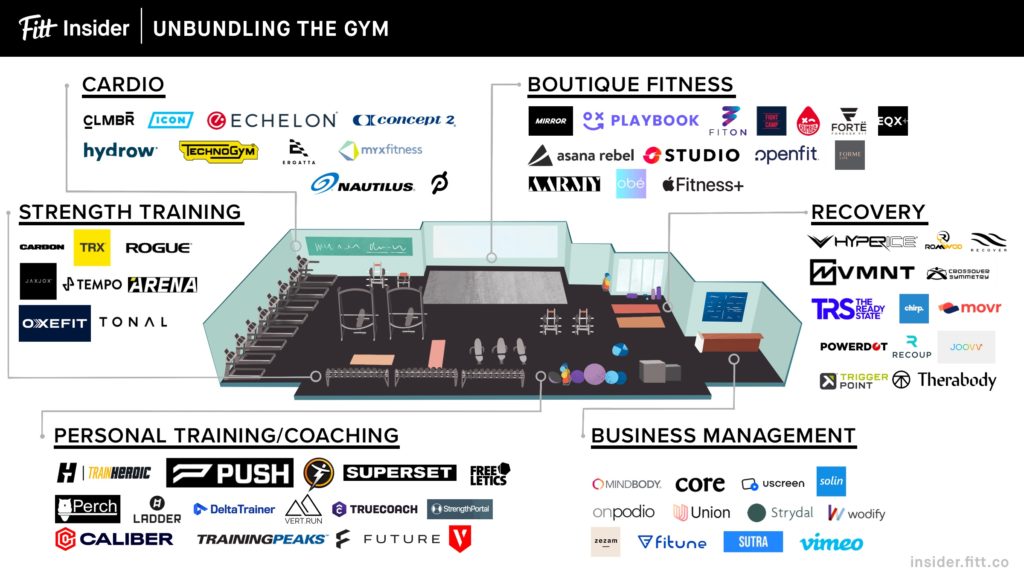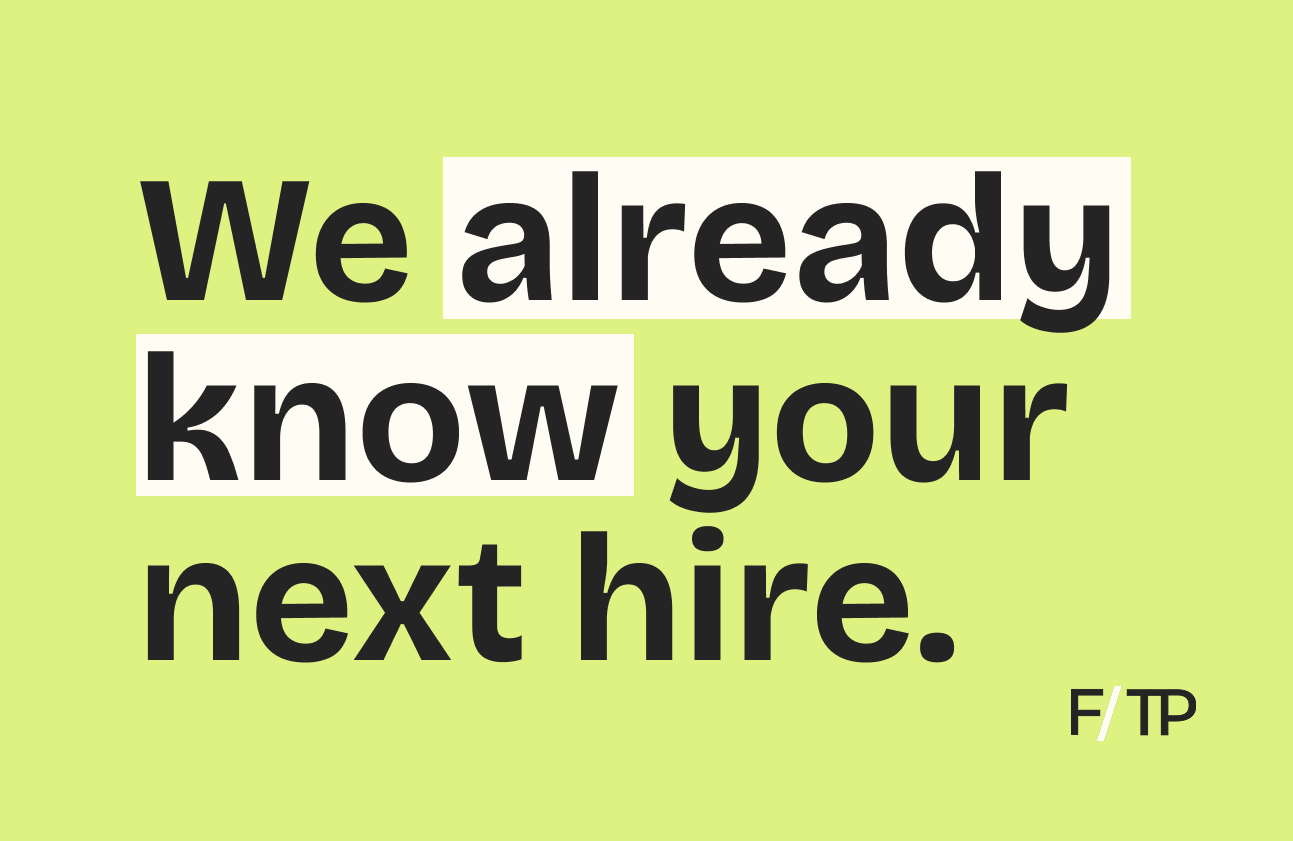Accelerated by the pandemic, the gym is being unbundled.
From connected equipment and digital communities to remote coaching, the business of fitness has been transformed.
The result?
Gyms and studios will no longer be the hub of a fitness seeker’s universe. Instead, they’ll be a spoke in the exercise ecosystem, giving way to a new kind of fitness bundle.
The Great Unbundling
Nothing new, lumbering incumbents fall victim to disruption. In tech circles, it’s a tale as old as… the internet.
In theory, an all-in-one platform is the holy grail. Among the early examples, horizontal platforms like Craigslist and eBay rose to prominence by serving a variety of adjacent verticals. But eventually, upstarts catering to a specific vertical begin to dissect the platform.
From banking to retail and higher education to healthcare, the unbundling analogy, when loosely applied, signals a shift to tech-enabled, narrowly focused, consumer-oriented solutions.
Specific to the fitness industry, as exercise moves beyond the four walls of a gym or studio, the entire value stream is being impacted.
Gradually, and Then Suddenly
Coronavirus didn’t create new behaviors; it accelerated existing trends.
In some ways, the unbundling began in the early 2000s with the rise of boutique fitness. The vertically focused alternative to a big-box gym, studios specializing in a single modality ushered in a new era of exercise.
More than a workout, fitness became an experience. Epitomized by candlelit rides at SoulCycle and bootcamp in the Red Room of Barry’s, studios became the place to sweat, see, and be seen. Compounded by community, membership to boutique studios grew by 121% between 2013 and 2017.
A welcomed trend, the brick-and-mortar fitness industry benefited from the studio boom.
According to the International Health, Racquet & Sportsclub Association (IHRSA), 2019 was “a year of abundance for the fitness industry.” In all, global revenues reached $94B and gyms/studio memberships were on pace to reach 230M members by 2030. Then, COVID happened.
From Place to Personality
Yes, the pandemic shuttered gyms and studios. But the advent of the celebrity instructor altered the industry long before the lockdowns.
Prior to March of 2020, while the industry’s growth was tied to physical locations, the value was shifting from place to personality. More than a workout or brand name, the instructor was the main attraction.
As this fact became clear, the balance of powers shifted. Soon, A-list instructors commanding top dollar got their way or started businesses of their own — opening a rival studio or launching a digital product.
Thanks to platforms like Instagram and YouTube, instructors and influencers rose to prominence. No longer limited by a physical location or an hourly wage (or a certification), fitness creators earned well into the six figures.
The prime example of a trainer turned creator turned full-blown founder, Kayla Itsines got her start by selling PDF workout guides. Now, her fitness app SWEAT has 1M active users/month and annual revenue approaching $100M.
Anywhere, Anytime
While exercisers and operators were consumed by the boutique fitness boom, innovators were sizing up the industry.
Don’t be fooled by the recent home workout gold rush. Peloton was founded in 2012, Zwift started in 2014, and Strava has been around since 2009. They’ve seen this day coming for some time; it’s consumers who are playing catch-up.
Now, the economics of exercise have fundamentally changed. From the means of distribution and the underlying business models to the core value proposition, the consumer, not the gym, is the central figure in the fitness universe.
This fact will be reflected in a continued evolution, one that prioritizes convenience, adherence, and personalization in addition to non-negotiables like fostering a strong sense of community and industry-leading instructors.
But, more than the changes we can see, the pandemic accelerated the rate of future innovations. Meaning: the Peloton of ‘X’ era—where consumers panic-bought smart bikes and connected fitness companies raised massive amounts of capital—will soon be the target of disruption.
As our “Unbundling” graphic illustrates, a new wave of disruption is upon us.
More specifically, the areas of “Personal Training/Coaching” and “Business Management” have exploded as fitness professionals, and entire brick-and-mortar businesses, move their operation online. Far from comprehensive, this graphic stops short of incorporating the impact of wearables like WHOOP and Oura, gamified options like Zwift or Supernatural, and aggregators like ClassPass.
Bundle and Unbundle
According to Jim Barksdale, the former CEO and President of Netscape, there are only two ways to make money in business: bundling and unbundling.
If that’s true, the future of fitness won’t be defined by hybrid or omnichannel offerings alone.
In reality, new bundles will emerge that combine digital and in-person offerings. For example, Life Time Fitness already offers Apple Fitness+ to its members.
Going a step further, nutrition, health data, and mental wellness will be bundled. And, as we’ve already seen, the bundles will move beyond working out as retailers like lululemon and tech giants like Apple bring exercise into their ecosystems — redefining what it means to be a fitness company in the first place.
🎙 On the Podcast
This week, on the Fitt Insider podcast, we’re joined by Alexa Meyer.
Alexa is the co-founder and CEO of Coa — a mental health and emotional fitness company offering therapist-led classes.
In this episode, we discuss:
- Coa’s mission to become the Nike of mental health
- Why we should treat mental fitness like going to the gym
- How in-person, community-focused classes help destigmatize therapy
- Why professional basketball player Kevin Love invested in the company
Listen to the full episode here.
☀️ Back to Basics
The hype around health tracking and fitness tech is at an all-time high. But the benefits of simply going outside can’t be overstated.
A recent WSJ article explored the power of spending more time in nature, suggesting that two hours outdoors is the new 10,000 steps.
We’ve become cut off from nature. According to a 2017 survey for the federal wildlife and park agencies, it’s “increasingly normal to spend little time outside.” And, in 2019, the average adult spent 11 and a half hours a day consuming media, according to Nielsen.
The pandemic has made matters even worse:
The physical and emotional toll the virus has taken—especially in urban areas with little green space—has galvanized doctors, researchers, and others to tap into nature’s therapeutic effects.
More and more, researchers see time outdoors as essential to health and longevity:
“Spending time in the woods… is strongly linked to lower blood pressure, heart rate and stress hormones and decreased anxiety, depression and fatigue.”
Callback: In Issue No. 80, we looked at the importance of parks, trails, green spaces, and bike lanes to our collective well-being, writing:
“Ultimately, fitness is exercise you pay for. And, in many ways, COVID is serving as a reminder that the best things in life are free.”
Looking ahead: Here’s hoping the walking, biking, and running boom of 2020 continues, signaling a shift to simpler, more accessible forms of physical activity for all.
🤝 Quantifying Community
According to McKinsey research, “The most successful fitness apps offer community.”
The report noted that community-focused fitness apps experience 4x growth over tracking- and training-centric apps.
Community is the rallying cry of boutique studios. And it was the topic of Issue No. 72, where we explored the idea of fitness as religion. In summary, a 2015 Harvard Divinity School study found that millennials were turning to fitness classes for meaning, ritual, and community.
Community is something we choose. With the entire world at our fingertips, place is no longer a limiting factor. As this trend continues, the strength of a brand’s digital community will make or break fitness companies.
Social+ Fitness. Despite all the hype around community, most digital fitness products are solo experiences that fail to capture the essence of exercising in person. Or as D’Arcy Coolican, an investment partner at Andreessen Horowitz, put it:
“Strava, for example, has some magical social elements, but hasn’t completely cracked the code yet. Peloton’s leaderboard is fun, but it’s a toe-in-the-water of what could be a deeper social experience. There’s so much more to build here that could capture the community of fitness enthusiasts. Imagine how engaging the first truly global social+ fitness product will be.”
For now, fitness is dominated by one-to-one or one-to-many models where the instructor or coach defines the experience.
Going beyond Facebook groups or Strava’s social network for athletes, it’s early days for digital fitness communities.
📰 News & Notes
- Echelon expands into France and Germany.
- With Every Stitch Considered, Nike enters workleisure.
- The Berkshire Hathaway for health and wellness brands.
- Stanford research: The causes and fixes for Zoom Fatigue.
- Roger Federer teams up with On Running for a tennis sneaker.
- Orangetheory Fitness: 90% of studios are open, 70% of members returned.
- The SEC cautions against athlete-backed SPACs. [Re-read: The SPACs are Coming]
💰 Money Moves
- Forward Health, a tech-enabled primary care startup, raised $225M in Series D funding.
More from Fitt Insider: The DTC Healthcare Report - Uplift Labs closed $3M in seed funding for its motion capture and remote coaching platform.
- London-based HelloSelf landed €6.4M ($7.6M) to grow its AI-powered digital therapy service.
More from Fitt Insider: Peak Burnout - Virgin Active’s UK business is set to receive $62.7M in funding from its shareholders as part of a restructuring.
- leAD Sports & Health Tech Partners and InStudio Ventures teamed up to launch The Draft, a sports tech incubator investing in and supporting startups.
- Vegano Foods, a plant-based meal kit delivery service, completed a $4.2M Series A funding round.
More from Fitt Insider: The Future of Meal Kits - Cloud Water Brands raised $2.7M in seed round funding for its functional beverage products.
- Global private equity firm CVC Capital Partners paid $509M for a 14.3% stake in the Six Nations, an annual men’s rugby tournament in Europe.
- BelliWelli, maker of gut-friendly, plant-based snack bars, raised $1M in seed funding.






